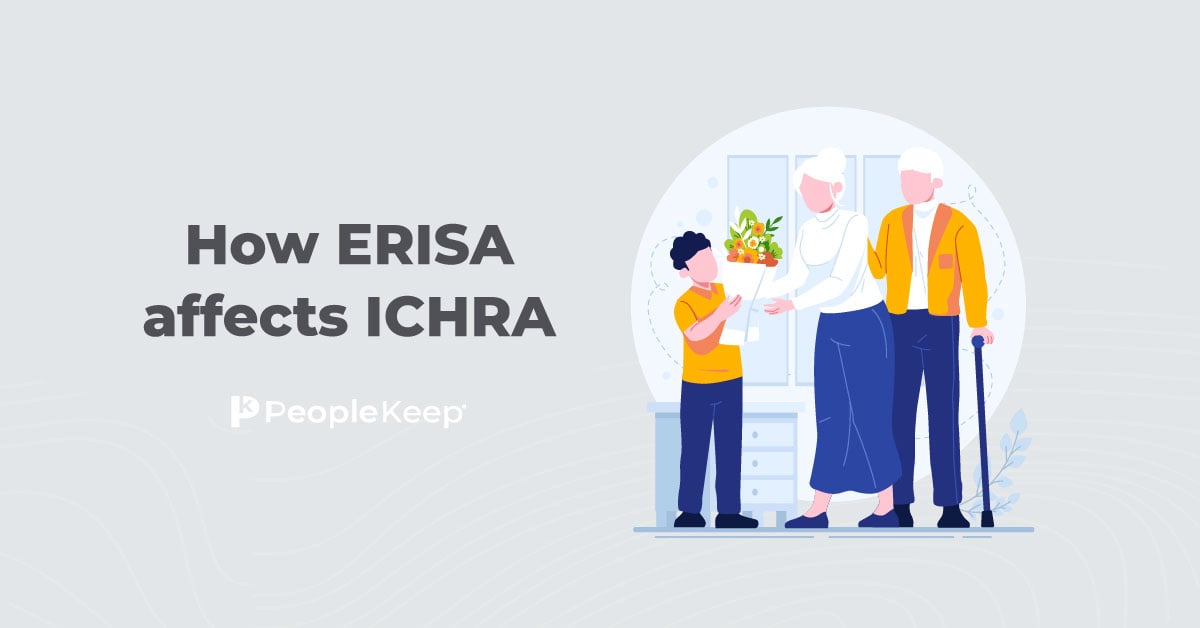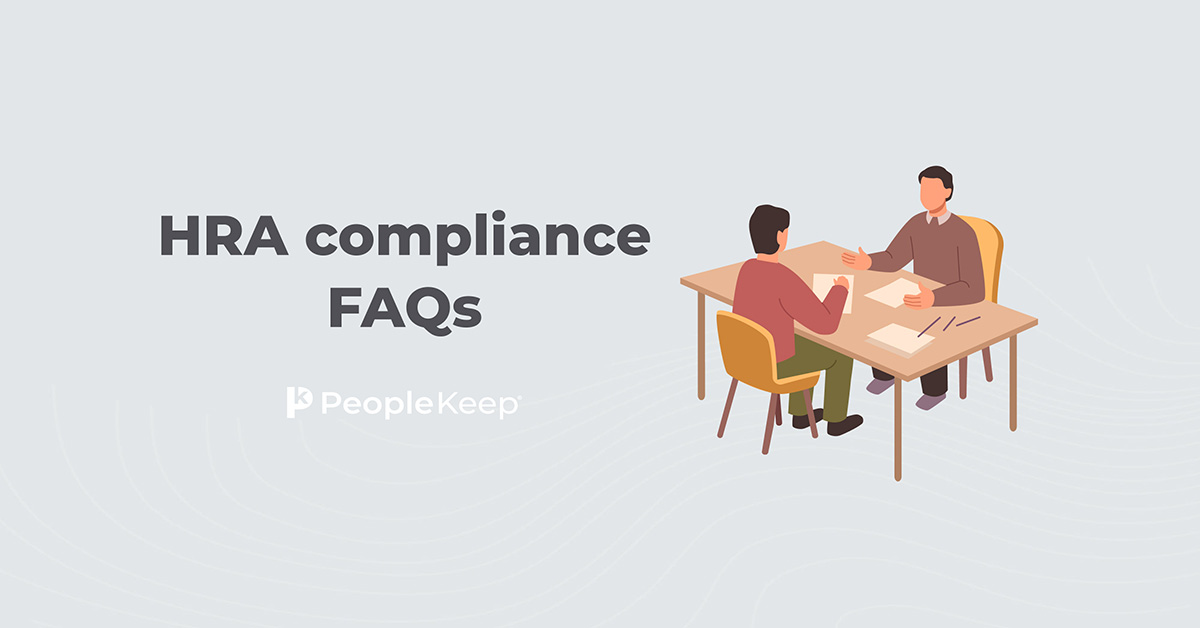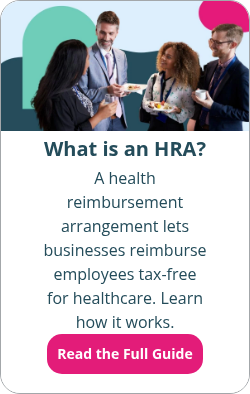Why you need compliant HRA software
By Elizabeth Walker on June 6, 2025 at 11:15 AM
For many small and mid-sized businesses, self-administering employee health benefits can seem like a cost-saving option. But even small compliance mistakes that result in a noncompliant benefit can cost your company thousands of dollars in fines.
If you offer a health reimbursement arrangement (HRA), using compliant HRA software is one of the best ways to protect your business from potential penalties. The right software helps ensure your benefit meets IRS regulations and other key guidelines, freeing up time so you can focus on different aspects of your organization.
In the article below, we’ll highlight nine commonly overlooked compliance requirements that make having HRA software an essential part of running your business.
In this blog post, you’ll learn:
- Key compliance regulations affecting HRA administration, such as ERISA, COBRA, and HIPAA.
- The Affordable Care Act (ACA) rules that apply to applicable large employers offering an HRA.
- How PeopleKeep by Remodel Health can simplify HRA administration and keep you compliant.
1. Affordable Care Act requirements
The Affordable Care Act (ACA) has significantly changed the health insurance industry. Since 2010, it’s helped expand Medicaid, created public health exchanges, and required qualified health plans to cover ten essential benefits.
However, the ACA also created specific requirements for employers offering HRAs and other employer-sponsored health plans. Under the ACA, these plans must follow health insurance market reforms1. A few examples of general rules under the ACA market reforms are allowing adult children to stay on their parents’ medical plan until age 26, requiring plans to provide preventive care without cost-sharing, and creating an appeals process for health claims.
Here are some ACA regulations that apply to HRAs:
- The employer shared responsibility provisions, also known as the employer mandate
- Applicable large employers (ALEs) with 50 or more full-time equivalent employees (FTEs) must offer an affordable health insurance plan that meets minimum essential coverage (MEC) and minimum value to at least 95% of their full-time workers and their dependents.
- If an ALE doesn’t comply with the mandate and at least one employee buys a medical plan with a subsidy on the individual market, they may be subject to an IRS tax penalty. Large employers offering an ICHRA need to ensure they’re offering an affordable allowance to satisfy the mandate.
- Minimum essential coverage (MEC)
- Employees with a qualified small employer HRA (QSEHRA) must have a health plan with MEC to participate in the benefit. For the individual coverage HRA (ICHRA), participating employees must have a qualifying form of individual health coverage to use the benefit. These qualifying forms of coverage must include MEC.
- Most traditional group health plans, individual plans, and government agency coverage, like Medicare and Medicaid, meet MEC requirements. However, for ICHRA, most government plans and Medicaid don’t count as individual coverage.
- Lifetime and annual limit rules
- Group health plans and individual health plans can’t place annual or lifetime maximums on the dollar amount of essential health benefits. This extends to any in-network or out-of-network services an individual may receive. The QSEHRA and ICHRA aren’t subject to these rules, but the individual plans employees select are.
- Summary of benefits and coverage (SBC)
- Some HRAs, like the QSEHRA and the ICHRA, require employers to provide employees with an SBC. An SBC outlines the plan’s covered services, limitations, exclusions, and eligible out-of-pocket medical expenses.
- 60-day notice of material modifications
- Benefit plan administrators must notify employees in writing or electronically of any modifications to their HRA benefit within 60 days of the changes taking effect.
2. PCORI fees
If you offer an ICHRA or QSEHRA, you must pay an annual fee to the Patient-Centered Outcomes Research Institute (PCORI). This fee helps fund research that provides individuals with better information to make better medical choices based on their health needs and outcomes.
For plan years ending between October 1, 2024, and September 30, 2025, the PCORI fee is $3.47 per covered individual. To determine your total amount, you’ll multiply $3.47 by the number of employees your plan covers.
If you owe a PCORI fee, you must pay it when you file IRS Form 720 by July 31 each year. If July 31 falls on a weekend or federal holiday, the payment deadline shifts to the next business day, typically August 1.
3. Form 1094 and 1095 reporting requirements
Another tax form that employers offering an ICHRA must file to stay compliant is Form 1095. This form outlines whether you provided health insurance to an employee during the prior tax year, whether the employee accepted the coverage, and the coverage duration throughout the year. You must distribute Form 1095 to all full-time employees employed for at least one month during the previous calendar year.
Employers must also file Form 1094, which is the summary cover sheet for all submitted 1095 forms for that tax year. For ALEs, he IRS uses this summary in Form 1094-C to assess potential employer penalties and determine whether any employees may qualify for premium tax credits.
The filing deadlines are February 28 for paper submissions and March 31 for electronic submissions. However, employers filing ten or more total tax returns must file electronically under the IRS’s consolidated filing rule.
ALEs must file Form 1095-C and 1094-C. Smaller employers offering an ICHRA don’t have to file Form 1095-C. But, they must provide Form 1095-B to report individual health insurance coverage information.
4. Form 5500
Employers offering an ICHRA must file Form 5500 under the Employee Retirement Income Security Act (ERISA). This annual form reports a wide range of details about your health plan’s financial status and operations for the plan year. The specific version of Form 5500 you must file depends on your company’s size and the number of eligible employees enrolled in your plan.
5. HIPAA Privacy Rule
HRAs must also follow the HIPAA Privacy Rule. This is because the plan administrator who reviews employees’ documentation and reimbursement requests receives protected health information (PHI), which is data that HIPAA protects by law.
HRA reimbursement claim documentation may contain several protected PHI, such as:
- Social Security numbers
- Medical record numbers
- Biometric identifiers
- Full-face photos
- Geographic data
If you’re offering a health benefit like an HRA, your plan administrator must keep your employees’ PHI safe so it’s not shared or viewed by those not authorized to see it. Employers that don’t comply or negligently release employees' PHI can face fines ranging from $100 to $50,000 per individual violation, depending on the level of seriousness2.
6. COBRA
The federal government considers HRAs group health plans (except for a QSEHRA, which is exempt from some group plan rules). This means they’re subject to regulations outlined by the Consolidated Omnibus Budget Reconciliation Act (COBRA).
COBRA allows former employees and their qualified dependents to continue their employer-sponsored health insurance coverage for typically 18 months after a qualifying event. It applies to all businesses with 20 or more FTEs that offer a group health plan to their staff.
However, almost every state requires employers with fewer than 20 employees to offer some form of continued coverage to employees. States refer to this as the “mini-COBRA” law.
Qualifying events that allow employees to get COBRA coverage include:
- Voluntary job loss
- Involuntary job loss for reasons other than gross misconduct
- Reduction of work hours
Qualified dependents and spouses may also receive continuation coverage under the following circumstances:
- The death of the employee
- Divorce
- The dependent child turns 26
- The covered employee becomes eligible for Medicare
If you offer an ICHRA or a group coverage HRA (GCHRA), you must give your former employees and their dependents the option to continue participating in the HRA. Employers who fail to extend COBRA coverage to participants can face hefty fines.
Here are the potential penalty amounts3:
- A fine of up to $110 per day from the Department of Labor for each qualified beneficiary who didn’t receive a timely COBRA notice.
- A $100 per day excise tax penalty from the IRS per qualified beneficiary.
- The fine can rise to $200 per day if not receiving the notice affects more than one family member.
In practice, electing COBRA with an ICHRA is likely more expensive for the employee than paying for an individual plan on their own. This is because they must pay a fee to access the HRA funds. But, employers still need to provide a COBRA notice.
7. Medicare reporting
Another regulatory compliance area HRA administrators must follow is the Medicare Secondary Payer (MSP) provisions. This legislation makes Medicare the secondary health insurance payer to certain primary plans. Proper reporting on how Medicare and primary plans interact ensures Medicare doesn’t overpay for services that the primary insurance carrier should pay.
Suppose you have employees enrolled in Medicare who also participate in your HRA. In that case, you must provide coverage information to the Centers for Medicare and Medicaid Services (CMS) per the MSP requirements.
These reporting requirements apply to all group health plans. But companies with fewer than 20 employees and employers that offer an annual HRA allowance of less than $5,000 per employee are exempt.
The detailed report you send CMS will allow better coordination of payer responsibilities between the employees’ HRA and Medicare plans. Employees who don’t follow MSP requirements may face a civil money penalty of up to $1,000 for each calendar day of noncompliance4.
HRAs are also subject to the Medicare Part D notice and disclosure requirements. Since an HRA doesn’t provide creditable coverage, you must provide a written notice of this to all Medicare-eligible employees and CMS.
8. Summary plan documents
Next, ERISA requires employers to establish and maintain their HRA plan with a “written instrument” known as a summary plan description (SPD).
An SPD is a summary of your benefit plan that outlines the benefit’s details and requirements, such as:
- Eligible medical expenses for reimbursement
- Employer contribution limits
- Allowance amounts
- Whether HRA funds may roll over from year to year
- How to file a tax-free reimbursement claim
If this is your first time offering an HRA, you must give your employees an SPD within 120 days of establishing the plan. Newly eligible participants in an existing HRA must receive their SPD within 90 days of their plan’s first date of coverage. Acceptable delivery methods include USPS First-Class Mail, in-person delivery at your company, and electronic delivery.
Not only could you face adverse action for failing to have a plan document, but it would also be difficult to prove and enforce the plan’s terms. Additionally, your employees won’t get the most out of their HRA if they don’t understand all the plan details.
9. ERISA-compliant reimbursement of individual health plans
Finally, the federal government has specific regulations that employers must comply with to reimburse employees for individual health insurance premiums without violating ERISA.
For example, an employer payment plan (EPP) is an arrangement where a business owner reimburses an employee for some or all of their individual health coverage premiums. While EPPs used to be popular before the ACA, they don’t comply with current ACA market reforms. If you offer an EPP, you could face a penalty of $100 per day per affected employee (or $36,500 per year per employee)5.
Under the ACA and ERISA, you can legally reimburse your employees for their individual health plan premiums and other eligible expenses with a QSEHRA or ICHRA. A GCHRA integrates with traditional group health insurance and is another way employers can cover their employees’ out-of-pocket medical expenses. However, group plan premiums aren’t eligible for reimbursement with a GCHRA.
How PeopleKeep by Remodel Health can help you compliantly administer your HRA
By now, you’re probably seeing how self-administering an HRA could be challenging. In addition to being time-consuming, you may need help with compliance requirements or find yourself in financial and legal jeopardy if you make a mistake.
If you’re a small business interested in an employee benefit administration tool, look no further than PeopleKeep by Remodel Health. Our cloud-based administration solution gives you an easy-to-use benefits platform to help manage your HRA.
PeopleKeep makes HRA compliance quick and easy by:
- Generating legal plan documents, like an SPD
- Helping with HRA plan designs to ensure affordability
- Drafting and sending employees timely HRA notices
- Reminding you when Form 720 PCORI fees are due and providing an estimate of the fee amount
- Confidently reviewing your employees’ claim documents for reimbursement requests
- Storing substantiation materials for reimbursement requests
- Keeping PHI safe in our secure administration platform
- Provide a data download for ALEs so they can complete Forms 1094 and 1095 easier
Most importantly, our software will help you stay compliant by keeping your benefits updated with all current rules and regulations. If you have a question, our award-winning support team is ready to provide guidance whenever you need it.
What about larger organizations with more compliance needs? Remodel Health’s ICHRA+ administration solution may be a good fit for ALEs seeking extra compliance assistance. At Remodel Health, we provide a white-glove, hands-on experience with dedicated support from a team of experts so you can offer a compliant and personalized benefit. If you need an ICHRA software platform and team that helps you with Forms 720, 1094, and 1095, then ICHRA+ may be just what you’re looking for.
Conclusion
HRAs are a flexible health benefit option for employers of all sizes. But that doesn’t mean they're free from compliance regulations that other health benefits must follow. From complying with the ACA to drafting legal plan documents, administering an HRA can feel daunting. But luckily, you don’t have to do it on your own.
At PeopleKeep by Remodel Health, we’re here to help you design and compliantly manage your QSEHRA, ICHRA, or GCHRA in just a few minutes per month. With our support and HRA administration tool, you’ll save time and avoid costly ACA penalties. Book a call with our HRA specialists to see how we can help you get started.
This article was originally published on June 5, 2016. It was last updated on June 6, 2025.
1. Health Insurance Market Reforms Health Insurance Market Reforms
2. HIPAA violations & enforcement
3.Understanding COBRA Notices: Compliance with Department of Labor Requirements
4. Medicare Secondary Payer and Certain Civil Money Penalties
Check out more resources
See these related articles

HRAs and W-2 annual reporting
Learn about HRA W-2 annual reporting requirements. Understand what employers need to include on employees' W-2 forms for HRA compliance.

How ERISA affects ICHRA
Understand how ERISA compliance affects your ICHRA plan with this informative guide. Learn the key regulations and requirements to ensure compliance.

HRA compliance FAQs
Need answers to your HRA compliance questions? Look no further! This comprehensive FAQ guide has everything you need to know about HRA compliance.



